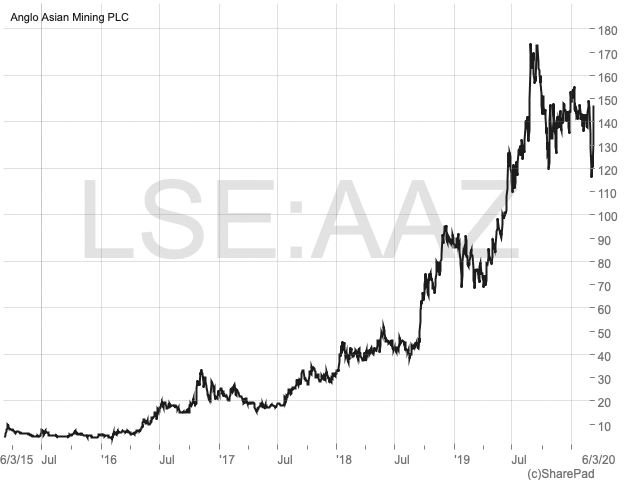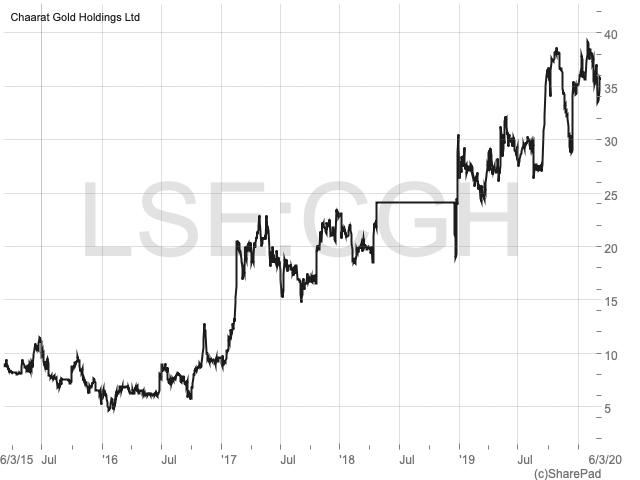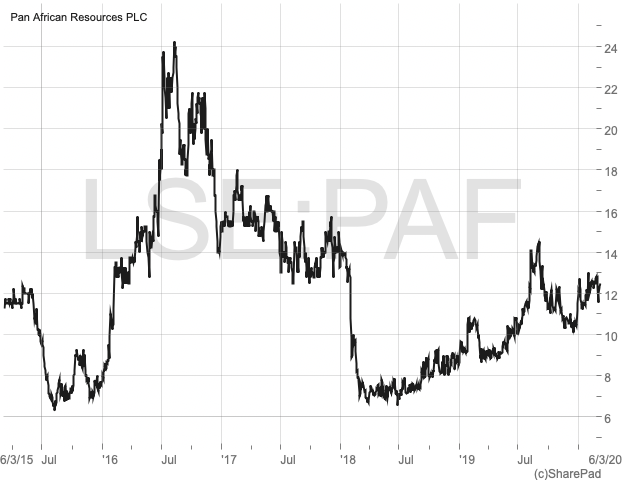Gold stocks update – is this the next Anglo Asian Mining?

With gold on the offensive in the midst of the coronavirus outbreak, John Cornford thinks he may have found the next Anglo Asian Mining…
Back in the August 2019 issue of Master Investor Mag, I admitted I’d missed the spectacular rise of Anglo Asian Mining (LON:AAZ), which had 7-bagged in two years to then 126p as its Azerbaijan gold (and copper) mine came into production and investors thereby lost their wariness about miners in that part of the world. Chaarat Gold (LON:CGH) – further east on the Tien-Shan gold belt in Tajikistan, but more recently also next door in Armenia) – looks like being the next one, although perhaps a bit more slowly.

Back then I also suggested taking that AAZ profit, as the shares in my view were fully up with the value still to come from its Gedebek mine – due to run out in a few years time. But news of ‘talks’ with the Azer government – which punters speculated might be about the future of AAZ’s profit sharing agreement with it and also due to run out – spurred them on to a 160p or so peak, since when they have marked time as speculation died down. I personally don’t think those talks will necessarily transfer more value to AAZ from the government (which basically owns all the country’s gold and leases it to miners in exchange for a share) and if it does in the form of more concessions, there will probably be a need for more spending to develop them, on top of that to replace Gedebek.
That’s still my view, although I will obviously be wrong-footed if the gold price continues up and AAZ rakes in more cash than expected.
But in its place it looks like Chaarat Gold Holdings (AIM:CGH) definitely merits interest as somewhere to redeploy profits from AAZ, and its share price chart since 2017 might show why.

Since its promising 2007 AIM listing, and peak 70p in the short-lived 2011 mining boom – after which market funding dried up – Chaarat had been trying to progress its potentially large Tulkubash copper/gold deposit in the west of Kyrgyzstan, envisaging a small scale operation to start with which it decided in 2013 was not economic. So it engaged Chinese consultants (with an aim to entice in a Chinese acquirer) who developed a scheme for the broader area around Tulkubash based on exploration that identified a resource of almost 7 million gold ounces, of which the Tulkubash core accounted for almost 1 million and would enable the production of up to 60,000 oz/yr.
This justified spending on a Bankable Feasibility Study to raise the funds, while at the same time in 2016 the company’s largest shareholder (over 30% through his Labro Investments), Martin Andersson, agreed to become chairman and use his extensive experience in Central Asia and the FSU to expand the company’s horizons.
This comprised searching for miners near the end of their producing lives who would deliver immediate cash profits to fund Chaarat’s development of Tulkubash, but for a low acquisition cost.
So it was that in April 2018 Chaarat took two significant steps, firstly making an offer to buy the prolific but end-of-life Kumtor mine near the Chinese border, while also negotiating to buy another already producing miner. After being suspended for the next nine months the shares were re-listed in January 2019 in a reverse takeover, with a completely new management and the acquisition for $55m (versus Chaarat’s £84m value when suspended) of the Kapan mine in Armenia, along with the raising of $100m in convertible bonds to fund its acquisition and the continuing development of Tulkubash.
In the event, Kumtor’s owner, Canada’s Centerra, never replied to the offer which has now lapsed, although the attempt shows how ambitious is Chaarat’s new management to keep expanding, saying it still has its eyes on similar opportunities among Central Asia’s and Russia’s fragmented gold industry.
Kapan had produced 50,000 oz of gold equivalent (including copper and silver) in 2017 with a $19m pre-tax profit, and was expecting to increase production by up to 25% over the next two years before running out of ore in 2023, although Chaarat has subsequently prolonged that life from recent exploration drilling.
So currently Chaarat is in the middle of a significant transformation which centres not only around Kapan and Tulkubash but also around an extension of Tulkubash into the much larger and nearby Kyzyltash prospect along the same trend.
| Master Investor Magazine
Never miss an issue of Master Investor Magazine – sign-up now for free! |
This has gold equivalent resources discovered so far amounting to 5.4 million ounces, compared with those supporting Tulkubash’s phase one project amounting to 1.6m ounces which will be mined over 5-6 years from 2021 at over 90,000 oz/yr.
A forecast cash of only $675/oz produces a 5% post-tax NPV of $70m (at a $1,300/oz gold price) for a $110m capital cost. In other words, after construction the NPV will be $180m earned over only five years, with a good if not exceptional 20% IRR. With gold now over $1,600/oz that will be substantially increased.
In a key step towards pouring first gold at Tulkubash by end 2021, March 2019 saw an agreement with Turkish Mining constructor and operator Ciftay, for it to collaborate in their construction and subscribe $31.5m for a 12.5% equity stake, in the Tulkubash and Kyzyltash projects together which at that stage valued them at $252m (or £200m).
This compares with CGH’s current £164m market cap – although it excludes nearly £80m of borrowings in the latest half-year balance sheet, including a large convertible loan, which bumps up Chaarat’s enterprise value to £244m including Kapan.
Kapan contributed $31m first-time revenues in 2019’s first half and was on track to produce 55,000 gold equivalent ounces for the whole year, while Chaarat’s latest estimate following more drilling is that its life can be extended to at least seven years at the same rate of production, delivering $20m of net annual earnings at a $1400/oz gold price (and over $30m at today’s gold price). So, it has been a worthwhile acquisition.
Following that extended plan Kapan’s 5% pre-tax NPV from now on is stated at $102m and at today’s gold price would be more than $140m (£112m).
Just at the moment I cannot find any broker estimates for Chaarat’s profits and share price targets over the next few years – perhaps understandably because there are currently too many spinning plates in the air, including the likelihood of the convertible loan adding more shares, and the still awaited project financing towards Tulkubash’s $110m start-up cost, expected in the next few months. While the company hopes the latter will be mainly in the form of a bank loan, it might be that the coronavirus slow-down will induce the bankers to demand an equity element, which might affect sentiment.
So, against the value set by the Ciftay deal on Tulkubash and Kyzyltash, and that Kapan NPV, the current enterprise value (equity plus loans) might be considered up with events so that the shares might mark time.
However, the full-year accounts due in April will show rather more up-to-date detail about both the balance sheet, operating costs, and spending requirements, which will enable analysts to start making forecasts.
But it is the prospect of Kyzyltash, which should produce over 200,000 oz/yr, a continuing strong gold price, and significant exploration potential in the still under-explored part of the Tulkubash gold trend, together with the cash from Kapan which will help towards developing Kyzyltash that makes the shares attractive over the medium term.
As for other goldies, I’m ignoring the coronavirus induced blip in the gold price which has reacted to the short-term threat of global bond investors selling off but now seems to be recovering. It is pleasing to see a more than 50% rise in Condor (LON:CNR) since my feature last month. The ultra cautious might take a profit for the moment while Condor refines its options for production at La India, which will almost certainly involve a fundraise. But long-term holders can probably hold on.
As for Pan African Resources (LON:PAF), which I said in August I preferred at 11p against AAZ, it hesitated subsequently when the reinstated dividend proved less than hoped in September, but since then the current year first-half results have encouraged analysts to re-iterate forecasts for a near-doubling of earnings this year and a more than doubled dividend next year. At the current 12.3p share price, that will deliver a more than 13% yield which, surely, no one can sneeze at. So, the shares have resumed their uptrend and remain a buy – perhaps more so than even CGH.


Comments (0)